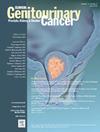pT3aN0M0型肾细胞癌根治和部分切除的倾向评分匹配分析
IF 2.7
3区 医学
Q3 ONCOLOGY
引用次数: 0
摘要
本研究旨在评估pT3aN0M0型肾细胞癌(RCC)患者行部分肾切除术(PN)和根治性肾切除术(RN)的肿瘤和功能预后。患者和方法我们对手术治疗的pT3aN0M0 RCC患者进行了回顾性分析。主要终点是全因死亡率/总生存率(ACM/OS)。次要结局是癌症特异性死亡率/癌症特异性生存率(CSM/CSS)、无复发/无进展生存率(PFS)和新发eGFR <;45 mL/min/1.73 m2 (CKD-S3b)。在卡尺宽度为0.01的范围内,以1:1的比例进行倾向得分匹配模型。采用Kaplan-Meier分析(KMA)和Cox多变量分析(MVA)来描述生存结局及其预测因素。结果PSM 359例(PN = 179, RN = 180);中位随访38.7 (IQR 16.28-64)个月。ACM的MVA显示,高分级(HR 2.05, P = 0.019)和最后随访的CKD-S3b (HR 2.13, P = 0.018)是独立危险因素,而RN与PN (P = 0.41)不是独立危险因素。CSM的MVA和复发表明,RN与PN不是CSM的独立危险因素(P = 0.088)和复发(P = 0.277)。CKD-S3b的MVA显示,RN与PN (HR 1.67 P = 0.025)与CKD-S3b风险增加相关。KMA比较PN和RN显示5年OS分别为87.4%和82% (P = 0.26);5年CSS分别为95.6%和90.3% (P = 0.15);5年PFS分别为83.5%和77% (P = 0.38);5年无CKD-S3b生存率分别为80.8%和65.5% (P = 0.016)。结论pn在降低eGFR和lt发生风险的同时具有肿瘤均衡性;45 mL/min/1.73 m2。在T3a RCC中,当功能保存的优先级被指出时,可以考虑PN。本文章由计算机程序翻译,如有差异,请以英文原文为准。
Propensity Score-Matched Analysis of Radical and Partial Nephrectomy in pT3aN0M0 Renal Cell Carcinoma
Background
We sought to evaluate oncological and functional outcomes of patients treated with partial nephrectomy (PN) and radical nephrectomy (RN) in pT3aN0M0 renal cell carcinoma (RCC).
Patients and Methods
We conducted a retrospective analysis of surgically treated pT3aN0M0 RCC patients. Primary outcome was all-cause mortality/overall survival (ACM/OS). Secondary outcomes were cancer-specific mortality/ cancer-specific survival (CSM/CSS), recurrence/progression free survival (PFS) and new onset de novo eGFR < 45 mL/min/1.73 m2 (CKD-S3b). A propensity score matched model in a 1:1 ratio was conducted, within a caliper width of 0.01. Kaplan–Meier analysis (KMA) and Cox multivariable analysis (MVA) were fitted to delineate survival outcomes and their predictors.
Results
After PSM 359 were analyzed (PN = 179 vs. RN = 180); median follow up of 38.7 (IQR 16.28-64) months. MVA for ACM revealed, high grade (HR 2.05, P = .019), and CKD-S3b at last follow up (HR 2.13, P = .018) as independent risk factors, while RN versus PN (P = .41) was not. MVA for CSM and recurrence revealed that RN versus PN was not an independent risk factor for CSM (P = .088) and recurrence (P = .277). MVA for CKD-S3b revealed RN versus PN (HR 1.67 P = .025) as associated with increased risk of CKD-S3b. KMA comparing PN versus RN revealed 5-year OS of 87.4% versus 82% (P = .26); 5-year CSS of 95.6% versus 90.3% (P = .15); 5-year PFS of 83.5% versus 77% (P = .38); 5-year CKD-S3b free survival of 80.8% versus 65.5% (P = .016).
Conclusion
PN exhibited oncological equipoise while reducing risk of development of eGFR < 45 mL/min/1.73 m2. PN may be considered in T3a RCC when prioritization of functional preservation is indicated.
求助全文
通过发布文献求助,成功后即可免费获取论文全文。
去求助
来源期刊

Clinical genitourinary cancer
医学-泌尿学与肾脏学
CiteScore
5.20
自引率
6.20%
发文量
201
审稿时长
54 days
期刊介绍:
Clinical Genitourinary Cancer is a peer-reviewed journal that publishes original articles describing various aspects of clinical and translational research in genitourinary cancers. Clinical Genitourinary Cancer is devoted to articles on detection, diagnosis, prevention, and treatment of genitourinary cancers. The main emphasis is on recent scientific developments in all areas related to genitourinary malignancies. Specific areas of interest include clinical research and mechanistic approaches; drug sensitivity and resistance; gene and antisense therapy; pathology, markers, and prognostic indicators; chemoprevention strategies; multimodality therapy; and integration of various approaches.
 求助内容:
求助内容: 应助结果提醒方式:
应助结果提醒方式:


